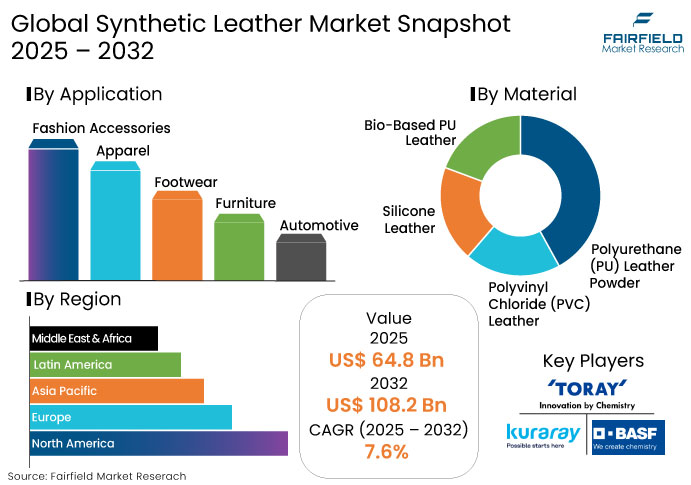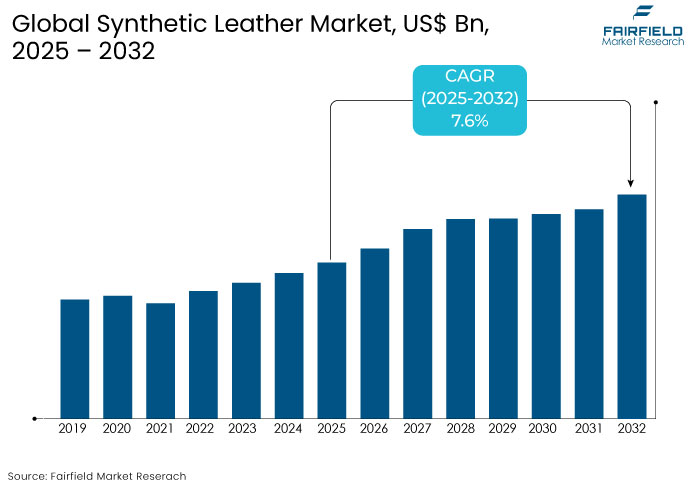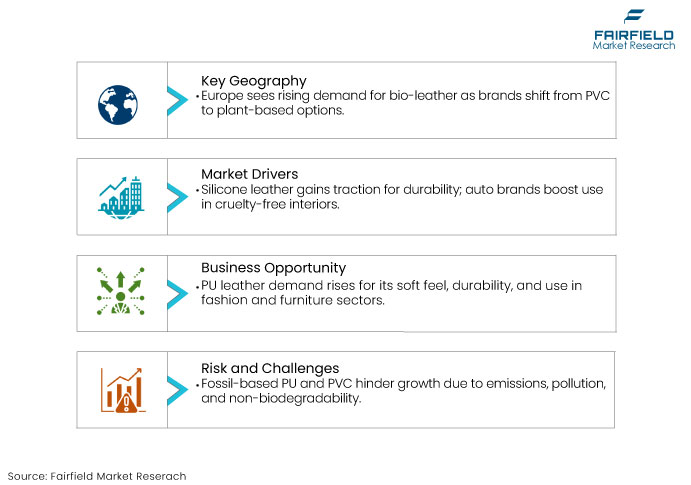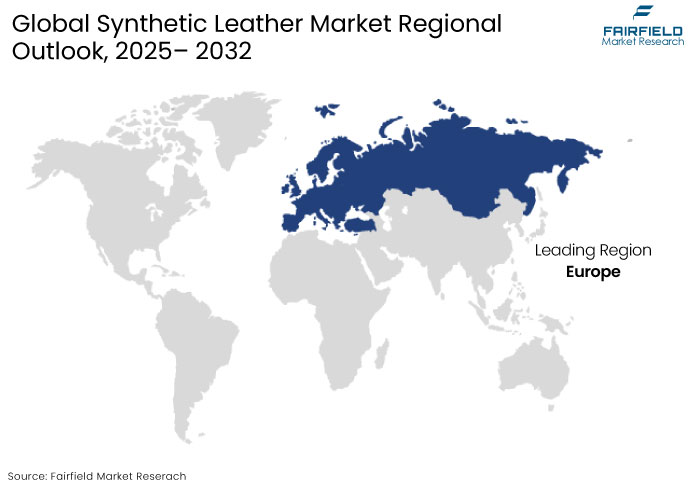Global Synthetic Leather Market Forecast
- The global synthetic leather market size is projected to grow from US$ 64.8 Bn in 2025 to US$ 108.2 Bn with a staggering CAGR of 7.6% by 2032.
- Growing demand for cruelty-free leather from the fashion and furniture industries are identified as the key growth drivers for the synthetic leather market.

Synthetic Leather Market Insights
- Increasing demand for soft, breathable, and high-quality alternatives drives PU leather adoption in fashion, furniture, and automotive applications.
- Cost-effectiveness and superior water resistance continue to fuel the demand for PVC leather, particularly in upholstery, footwear, and accessories.
- Growing environmental concerns and innovations in plant-derived materials are accelerating market expansion for bio-based leather in luxury fashion, automotive, and furniture sectors.
- Increasing adoption by global brands such as Nike and Puma accelerates market expansion for synthetic leather in sports and casual footwear.
- Growing demand for durable, easy-to-maintain, and eco-friendly upholstery is boosting the use of synthetic leather in home and office furniture.
- Expanding vehicle production and stringent VOC regulations propel the adoption of high-performance synthetic leather in car interiors and upholstery.
- Rise in demand for sustainable and high-performance synthetic leather in automotive and luxury goods is driving steady market growth for North America.
- In Europe, stringent environmental regulations and the shift towards vegan fashion are accelerating the adoption of eco-friendly synthetic leather alternatives.
- Dominating global production, Asia Pacific is booming for the fashion, footwear, and automotive industries as the synthetic leather market expands.
A Look Back and a Look Forward - Comparative Analysis
Between 2019 and 2024, the global synthetic leather market experienced steady growth, driven by increasing consumer demand for affordable and versatile alternatives to genuine leather. However, significant challenges, notably the COVID-19 pandemic led to disruptions in supply chain, decreased demand in key sectors such as automotive and furniture due to widespread shutdown. Additionally, geopolitical tensions such as the Russia-Ukraine conflict further impacted market dynamics. Despite these hurdles, some companies, such as Koi Footwear leveraged the rise in e-commerce platforms for selling synthetic leather products through positioning as an environmentally conscious fashion brand.
In the forecast period from 2025 to 2032, the synthetic leather market is poised for continued expansion, driven by innovations in bio-based and sustainable alternatives. Growing environmental concerns and consumer preferences for eco-friendly products are prompting manufacturers to explore materials derived from plant-based and recycled sources, such as pineapple, mushroom, and apple waste. Major industry players are responding to this shift; for example, in 2024, the BMW Group announced plans to use organic and recycled materials for vehicle interiors, underlining their commitment to sustainability.
Key Growth Determinants
- Significant demand for silicon based leather due to its long durability and high abrasion resistance
Silicone-based synthetic leather is gaining significant traction in the global market due to its exceptional durability and high abrasion resistance. These qualities are particularly suitable for high-traffic applications such as automotive upholstery and furniture. In the automotive sector, the shift towards cruelty-free and durable materials has led to a 25% increase in the adoption of synthetic leather for car interiors, with major manufacturers like Tesla and BMW integrating these materials into their designs.
Recognizing this trend, industry players are innovating to meet the demand. For instance, in April 2023, General Silicones Co., Ltd. launched Compo-SiL (SL series), a vegan synthetic leather targeting manufacturers of bags, wallets, backpacks, and shoes. Similarly, in July 2022, Sage Automotive Interiors introduced silicone synthetic leather for automotive applications, commencing production in Shanghai, China. These developments underscore the growing preference for silicone-based leather, driven by its superior performance and sustainability.

Key Growth Barriers
- Polymer-based synthetic leather relies on fossil fuel feedstock violates sustainable manufacturing practices
The polymer-derived synthetic leather market faces significant restraints due to its reliance on fossil fuel-derived polymers such as polyurethane and polyvinyl chloride. The production of these materials is energy-intensive and emits volatile organic compounds and greenhouse gases, contributing to global warming and reduced air quality. Additionally, PU and PVC are non-biodegradable, leading to persistent environmental pollution as synthetic leather products accumulate in landfills and oceans.
Health concerns also arise from the production processes; PU manufacturing releases harmful chemicals that can cause respiratory issues among factory workers, while PVC production emits toxic substances such as dioxins, posing risks to human and animal health. These environmental and health drawbacks, coupled with increasing consumer demand for sustainable products, are restraining the growth of the synthetic leather market and prompting a shift towards eco-friendly alternatives.
Synthetic Leather Market Trends, Opportunities, and Threat
- Soft, breathable, and flexible Polyurethane (PU) leather has the highest demand from various industrial applications, such as fashion and furniture
The demand for polyurethane synthetic leather is surging due to its soft texture, breathability, and flexibility, making it a preferred alternative to genuine leather. PU leather is widely used in fashion, including footwear, handbags, and apparel, due to its lightweight nature, comfort, and ability to mimic real leather’s appearance. Additionally, the furniture industry is a major consumer, as PU leather offers durability, ease of maintenance, and resistance to cracking, making it suitable for upholstery and automotive interiors.
Compared to polyvinyl chloride leather, PU leather is more environmentally friendly as it does not release harmful dioxins and has a lower carbon footprint. The increasing focus on sustainability and cruelty-free alternatives in the fashion and furniture sectors further supports PU leather’s dominance. Innovations in bio-based and waterborne PU leather also contribute to market growth, aligning with consumer preferences for sustainable and high-performance synthetic materials.
- Innovation and development of plant-derived bio-based leather present a significant threat to market expansion
The innovation and development of plant-derived bio-based leather is an indirect threat for the synthetic leather market since its popularity is growing based on sustainability concerns and demand for eco-friendly alternatives. Unlike traditional PU and PVC, synthetic leather, bio-based leather is made from renewable sources such as cactus, pineapple leaves (Piñatex), mushrooms (mycelium), and apple peels. These materials provide a lower environmental footprint by reducing reliance on fossil fuels and minimizing toxic emissions during production.
With growing consumer awareness and stringent regulations on synthetic leather production, bio-based alternatives appeal to the fashion, automotive, and furniture industries seeking sustainable and cruelty-free options. Leading brands invest in plant-based leather to enhance their green credentials, further driving market adoption. Additionally, advancements in material engineering are improving the durability, aesthetics, and performance of bio-based leather, making it a viable replacement for conventional synthetic and genuine leather across multiple applications. Therefore, these factors account for decline in synthetic leather made materials in consumer good and automotive.

Leading Segment Overview
- The automotive industry offers lucrative opportunities for synthetic leather usage
The automotive industry is a major driver of the synthetic leather market expansion, driven by increasing vehicle production, growing EV adoption, and the shift toward sustainable interiors. Global vehicle production surpassed 85 million units in 2023 and is projected to exceed 100 million units by 2030, creating substantial demand for synthetic leather in upholstery, steering wheels, and dashboards.
Over 50% of luxury car brands have already replaced genuine leather with synthetic alternatives, with major automakers such as Tesla, BMW, and Mercedes-Benz adopting high-quality polyurethane and bio-based materials to align with sustainability goals. The electric vehicle sector, expected to account for 40% of total vehicle sales by 2030, accelerates this trend, as automakers seek lightweight and eco-friendly materials.
With the automotive synthetic leather market projected to grow steadily, backed by rising premium car production and increasing commercial vehicle adoption, this sector presents the highest opportunity for market expansion.
Regional Analysis
- Significant demand for bio-derived synthetic leather in Europe due to growing regulations and environmental concerns
Europe is witnessing a surge in demand for bio-derived synthetic leather, driven by stringent environmental regulations and growing consumer preference for sustainable materials. The EU’s Green Deal and the REACH regulation have imposed strict limits on hazardous substances in synthetic leather production, accelerating the shift toward plant-based alternatives. In 2023, over 60% of European fashion and automotive brands committed to phasing out PVC-based leather in favor of bio-derived options like mycelium, apple leather, and pineapple leather.
The European automotive industry, producing over 15 million vehicles annually, is a major adopter, with brands such as BMW and Mercedes-Benz integrating bio-based leather into their interiors. Additionally, the European vegan leather market is expected to exceed USD 10 billion by 2030, reflecting strong growth potential. As sustainability remains a key priority, the demand for bio-derived synthetic leather in fashion, furniture, and automotive sectors across Europe is set to rise significantly.

- Automotive Industry in North America is adopting synthetic leather for automotive interiors
The North American automotive industry is rapidly adopting synthetic leather for vehicle interiors, driven by increasing consumer demand for sustainable, high-performance materials. In 2023, over 60% of newly manufactured vehicles in North America incorporated synthetic leather in seats, dashboards, and door trims, replacing traditional genuine leather. Leading automakers such as Ford, General Motors, and Tesla are integrating high-quality polyurethane (PU) and bio-based synthetic leather to enhance durability, reduce costs, and align with environmental regulations.
The U.S. automotive market, which produced over 10 million vehicles in 2023, is witnessing strong growth in electric vehicles, a segment where synthetic leather adoption is even higher due to its lightweight and sustainable attributes. Additionally, the luxury vehicle segment in North America grew by 12% year-over-year, further fueling demand for premium synthetic leather interiors. With increasing regulatory pressure on animal-derived products and rising consumer preference for cruelty-free materials, the adoption of synthetic leather in North American automotive interiors is set to expand significantly.
- Fashion-industry in Asia Pacific reveals a high demand for alternative leather due to its low cost
The Asia Pacific fashion industry is driving strong demand for alternative leather, primarily due to its affordability and growing consumer preference for sustainable materials. The region accounts for over 40% of global apparel and footwear sales, with countries such as China, India, and Indonesia emerging as key markets for synthetic leather. In 2023, China alone produced over 12 billion pairs of footwear, with a significant portion using polyurethane (PU) leather due to its lower cost compared to genuine leather.
Additionally, India’s fashion retail market, valued at over US$ 100 billion, is witnessing a surge in demand for synthetic leather-based apparel, handbags, and accessories, fueled by price-conscious consumers. Leading brands and manufacturers are shifting to PU and bio-based leather alternatives to cater to the region’s growing middle-income population. With fast fashion expanding rapidly and sustainability concerns rising, the demand for cost-effective alternative leather in Asia Pacific is set to accelerate further growth.
Competitive Landscape
The global synthetic leather market is witnessing intense competition, driven by innovation, sustainability initiatives, and strategic collaborations. Leading players are increasingly focusing on plant-based and biodegradable alternatives to meet rising consumer demand for cruelty-free and eco-friendly materials.
Companies are investing in novel bio-based formulations, such as fruit waste-derived and polymer-based synthetic leathers, offering enhanced customization in texture, color, and durability. The luxury and furniture sectors are also adopting plant-based upholstery, signaling a broader industry shift away from traditional leather.
Collaborations between material science firms and research institutions are accelerating the development of next-generation synthetic leather, incorporating advanced coatings and fiber technologies for improved performance. Additionally, global fashion and sportswear brands are actively promoting environmental awareness through campaigns that educate consumers on sustainable leather alternatives.
With regulatory pressures and sustainability commitments shaping industry strategies, the competitive landscape is poised for rapid transformation, favoring innovation-driven and eco-conscious market players.
- In October 2024, Puma teamed up with a UN Global Ambassador to introduce the #KnowYourStuff video series, shedding light on the environmental challenges associated with leather and vegan alternatives. This initiative supports the rising shift toward plant-based and cruelty-free materials in the fashion industry.
- In June 2024, a collaborative effort between Denkendorf (German Institutes for Textile and Fiber Research) (DITF), Freiberg Institute gGmbH (FILK), and the AiF project led to the development of a sustainable synthetic leather using polybutylene succinate (PBS). This innovative material is designed for both fiber and coating applications, effectively replicating the texture and performance of traditional artificial leather. The use of PBS enhances durability while ensuring an eco-friendlier alternative to conventional synthetic leather, aligning with the industry's growing focus on sustainability and biodegradable materials.
Key Companies
- Toray Industries Inc.
- Kuraray Co. Ltd.
- San Fang Chemical Industry Co., Ltd.
- BASF SE
- Dow Inc.
- TEIJIN FRONTIER(U.S.A.), INC.
- Zhejiang Hexin New Material Co., Ltd.
- Yantai Wanhua Huayi Polyurethane Products Co., Ltd.
- Alfatex
- FILWEL Co., Ltd.
- Kolon Industries, Inc.
An Expert’s Eye
- The market is witnessing a shift towards eco-friendly materials, with companies such as BASF and MycoWorks introducing low-VOC, recyclable, and mycelium-based synthetic leathers. These innovations address growing environmental concerns and regulatory pressures, driving demand for sustainable alternatives across industries.
- With 23 million car sales in the Americas in 2023, including 16 million in the U.S., the demand for high-performance synthetic leather in automotive interiors is surging. Premium solutions like Dow’s LuxSense™ and BASF’s TPU-based Elastollan® are gaining traction as automakers seek durable, low-emission alternatives to meet strict VOC regulations.
- Leading brands such as Nike and Puma are shifting away from traditional leather, replacing kangaroo leather with synthetic alternatives. Additionally, the APAC apparel industry, dominating 60% of the global trade, continues to drive demand for cost-effective and sustainable synthetic leather solutions.
- Italy is a major producer of EU leather and faces environmental challenges, since 30% of leather waste is classified as hazardous. This accelerates the transition toward synthetic and bio-based alternatives, offering a significant market opportunity for sustainable solutions.
Global Synthetic Leather Market is Segmented as-
By Material Type
- Polyurethane (PU) Leather
- Polyvinyl Chloride (PVC) Leather
- Silicone Leather
- Bio-Based PU Leather
By Application
- Fashion Accessories
- Apparel
- Footwear
- Furniture
- Automotive
- Others
By Region
- North America
- Europe
- Asia Pacific
- Latin America
- Middle East & Africa
1. Executive Summary
1.1. Global Synthetic Leather Market Snapshot
1.2. Future Projections
1.3. Key Market Trends
1.4. Regional Snapshot, by Value, 2025
1.5. Analyst Recommendations
2. Market Overview
2.1. Market Definitions and Segmentations
2.2. Market Dynamics
2.2.1. Drivers
2.2.2. Restraints
2.2.3. Market Opportunities
2.3. Value Chain Analysis
2.4. COVID-19 Impact Analysis
2.5. Porter's Fiver Forces Analysis
2.6. Impact of Russia-Ukraine Conflict
2.7. PESTLE Analysis
2.8. Regulatory Analysis
2.9. Price Trend Analysis
2.9.1. Current Prices and Future Projections, 2024-2032
2.9.2. Price Impact Factors
3. Global Synthetic Leather Market Outlook, 2019 - 2032
3.1. Global Synthetic Leather Market Outlook, by Type, Value (US$ Mn) & Volume (Tons), 2019-2032
3.1.1. Polyurethane (PU) Leather
3.1.2. Polyvinyl Chloride (PVC) Leather
3.1.3. Silicone Leather
3.1.4. Bio-Based PU Leather
3.2. Global Synthetic Leather Market Outlook, by Application, Value (US$ Mn) & Volume (Tons), 2019-2032
3.2.1. Fashion Accessories
3.2.2. Apparel
3.2.3. Footwear
3.2.4. Furniture
3.2.5. Automotive
3.2.6. Others
3.3. Global Synthetic Leather Market Outlook, by Region, Value (US$ Mn) & Volume (Tons), 2019-2032
3.3.1. North America
3.3.2. Europe
3.3.3. Asia Pacific
3.3.4. Latin America
3.3.5. Middle East & Africa
4. North America Synthetic Leather Market Outlook, 2019 - 2032
4.1. North America Synthetic Leather Market Outlook, by Type, Value (US$ Mn) & Volume (Tons), 2019-2032
4.1.1. Polyurethane (PU) Leather
4.1.2. Polyvinyl Chloride (PVC) Leather
4.1.3. Silicone Leather
4.1.4. Bio-Based PU Leather
4.2. North America Synthetic Leather Market Outlook, by Application, Value (US$ Mn) & Volume (Tons), 2019-2032
4.2.1. Fashion Accessories
4.2.2. Apparel
4.2.3. Footwear
4.2.4. Furniture
4.2.5. Automotive
4.2.6. Others
4.3. North America Synthetic Leather Market Outlook, by Country, Value (US$ Mn) & Volume (Tons), 2019-2032
4.3.1. U.S. Synthetic Leather Market Outlook, by Type, 2019-2032
4.3.2. U.S. Synthetic Leather Market Outlook, by Application, 2019-2032
4.3.3. Canada Synthetic Leather Market Outlook, by Type, 2019-2032
4.3.4. Canada Synthetic Leather Market Outlook, by Application, 2019-2032
4.4. BPS Analysis/Market Attractiveness Analysis
5. Europe Synthetic Leather Market Outlook, 2019 - 2032
5.1. Europe Synthetic Leather Market Outlook, by Type, Value (US$ Mn) & Volume (Tons), 2019-2032
5.1.1. Polyurethane (PU) Leather
5.1.2. Polyvinyl Chloride (PVC) Leather
5.1.3. Silicone Leather
5.1.4. Bio-Based PU Leather
5.2. Europe Synthetic Leather Market Outlook, by Application, Value (US$ Mn) & Volume (Tons), 2019-2032
5.2.1. Fashion Accessories
5.2.2. Apparel
5.2.3. Footwear
5.2.4. Furniture
5.2.5. Automotive
5.2.6. Others
5.3. Europe Synthetic Leather Market Outlook, by Country, Value (US$ Mn) & Volume (Tons), 2019-2032
5.3.1. Germany Synthetic Leather Market Outlook, by Type, 2019-2032
5.3.2. Germany Synthetic Leather Market Outlook, by Application, 2019-2032
5.3.3. Italy Synthetic Leather Market Outlook, by Type, 2019-2032
5.3.4. Italy Synthetic Leather Market Outlook, by Application, 2019-2032
5.3.5. France Synthetic Leather Market Outlook, by Type, 2019-2032
5.3.6. France Synthetic Leather Market Outlook, by Application, 2019-2032
5.3.7. U.K. Synthetic Leather Market Outlook, by Type, 2019-2032
5.3.8. U.K. Synthetic Leather Market Outlook, by Application, 2019-2032
5.3.9. Spain Synthetic Leather Market Outlook, by Type, 2019-2032
5.3.10. Spain Synthetic Leather Market Outlook, by Application, 2019-2032
5.3.11. Russia Synthetic Leather Market Outlook, by Type, 2019-2032
5.3.12. Russia Synthetic Leather Market Outlook, by Application, 2019-2032
5.3.13. Rest of Europe Synthetic Leather Market Outlook, by Type, 2019-2032
5.3.14. Rest of Europe Synthetic Leather Market Outlook, by Application, 2019-2032
5.4. BPS Analysis/Market Attractiveness Analysis
6. Asia Pacific Synthetic Leather Market Outlook, 2019 - 2032
6.1. Asia Pacific Synthetic Leather Market Outlook, by Type, Value (US$ Mn) & Volume (Tons), 2019-2032
6.1.1. Polyurethane (PU) Leather
6.1.2. Polyvinyl Chloride (PVC) Leather
6.1.3. Silicone Leather
6.1.4. Bio-Based PU Leather
6.2. Asia Pacific Synthetic Leather Market Outlook, by Application, Value (US$ Mn) & Volume (Tons), 2019-2032
6.2.1. Fashion Accessories
6.2.2. Apparel
6.2.3. Footwear
6.2.4. Furniture
6.2.5. Automotive
6.2.6. Others
6.3. Asia Pacific Synthetic Leather Market Outlook, by Country, Value (US$ Mn) & Volume (Tons), 2019-2032
6.3.1. China Synthetic Leather Market Outlook, by Type, 2019-2032
6.3.2. China Synthetic Leather Market Outlook, by Application, 2019-2032
6.3.3. Japan Synthetic Leather Market Outlook, by Type, 2019-2032
6.3.4. Japan Synthetic Leather Market Outlook, by Application, 2019-2032
6.3.5. South Korea Synthetic Leather Market Outlook, by Type, 2019-2032
6.3.6. South Korea Synthetic Leather Market Outlook, by Application, 2019-2032
6.3.7. India Synthetic Leather Market Outlook, by Type, 2019-2032
6.3.8. India Synthetic Leather Market Outlook, by Application, 2019-2032
6.3.9. Southeast Asia Synthetic Leather Market Outlook, by Type, 2019-2032
6.3.10. Southeast Asia Synthetic Leather Market Outlook, by Application, 2019-2032
6.3.11. Rest of SAO Synthetic Leather Market Outlook, by Type, 2019-2032
6.3.12. Rest of SAO Synthetic Leather Market Outlook, by Application, 2019-2032
6.4. BPS Analysis/Market Attractiveness Analysis
7. Latin America Synthetic Leather Market Outlook, 2019 - 2032
7.1. Latin America Synthetic Leather Market Outlook, by Type, Value (US$ Mn) & Volume (Tons), 2019-2032
7.1.1. Polyurethane (PU) Leather
7.1.2. Polyvinyl Chloride (PVC) Leather
7.1.3. Silicone Leather
7.1.4. Bio-Based PU Leather
7.2. Latin America Synthetic Leather Market Outlook, by Application, Value (US$ Mn) & Volume (Tons), 2019-2032
7.2.1. Fashion Accessories
7.2.2. Apparel
7.2.3. Footwear
7.2.4. Furniture
7.2.5. Automotive
7.2.6. Others
7.3. Latin America Synthetic Leather Market Outlook, by Country, Value (US$ Mn) & Volume (Tons), 2019-2032
7.3.1. Brazil Synthetic Leather Market Outlook, by Type, 2019-2032
7.3.2. Brazil Synthetic Leather Market Outlook, by Application, 2019-2032
7.3.3. Mexico Synthetic Leather Market Outlook, by Type, 2019-2032
7.3.4. Mexico Synthetic Leather Market Outlook, by Application, 2019-2032
7.3.5. Argentina Synthetic Leather Market Outlook, by Type, 2019-2032
7.3.6. Argentina Synthetic Leather Market Outlook, by Application, 2019-2032
7.3.7. Rest of LATAM Synthetic Leather Market Outlook, by Type, 2019-2032
7.3.8. Rest of LATAM Synthetic Leather Market Outlook, by Application, 2019-2032
7.4. BPS Analysis/Market Attractiveness Analysis
8. Middle East & Africa Synthetic Leather Market Outlook, 2019 - 2032
8.1. Middle East & Africa Synthetic Leather Market Outlook, by Type, Value (US$ Mn) & Volume (Tons), 2019-2032
8.1.1. Polyurethane (PU) Leather
8.1.2. Polyvinyl Chloride (PVC) Leather
8.1.3. Silicone Leather
8.1.4. Bio-Based PU Leather
8.2. Middle East & Africa Synthetic Leather Market Outlook, by Application, Value (US$ Mn) & Volume (Tons), 2019-2032
8.2.1. Fashion Accessories
8.2.2. Apparel
8.2.3. Footwear
8.2.4. Furniture
8.2.5. Automotive
8.2.6. Others
8.3. Middle East & Africa Synthetic Leather Market Outlook, by Country, Value (US$ Mn) & Volume (Tons), 2019-2032
8.3.1. GCC Synthetic Leather Market Outlook, by Type, 2019-2032
8.3.2. GCC Synthetic Leather Market Outlook, by Application, 2019-2032
8.3.3. South Africa Synthetic Leather Market Outlook, by Type, 2019-2032
8.3.4. South Africa Synthetic Leather Market Outlook, by Application, 2019-2032
8.3.5. Egypt Synthetic Leather Market Outlook, by Type, 2019-2032
8.3.6. Egypt Synthetic Leather Market Outlook, by Application, 2019-2032
8.3.7. Nigeria Synthetic Leather Market Outlook, by Type, 2019-2032
8.3.8. Nigeria Synthetic Leather Market Outlook, by Application, 2019-2032
8.3.9. Rest of Middle East Synthetic Leather Market Outlook, by Type, 2019-2032
8.3.10. Rest of Middle East Synthetic Leather Market Outlook, by Application, 2019-2032
8.4. BPS Analysis/Market Attractiveness Analysis
9. Competitive Landscape
9.1. Company Vs Segment Heatmap
9.2. Company Market Share Analysis, 2024
9.3. Competitive Dashboard
9.4. Company Profiles
9.4.1. TORAY INDUSTRIES, INC.
9.4.1.1. Company Overview
9.4.1.2. Product Portfolio
9.4.1.3. Financial Overview
9.4.1.4. Business Strategies and Developments
9.4.2. Kuraray Co. Ltd.
9.4.2.1. Company Overview
9.4.2.2. Product Portfolio
9.4.2.3. Financial Overview
9.4.2.4. Business Strategies and Developments
9.4.3. San Fang Chemical Industry Co., Ltd.
9.4.3.1. Company Overview
9.4.3.2. Product Portfolio
9.4.3.3. Financial Overview
9.4.3.4. Business Strategies and Developments
9.4.4. BASF SE
9.4.4.1. Company Overview
9.4.4.2. Product Portfolio
9.4.4.3. Financial Overview
9.4.4.4. Business Strategies and Developments
9.4.5. NAN YA PLASTICS CORPORATION
9.4.5.1. Company Overview
9.4.5.2. Product Portfolio
9.4.5.3. Financial Overview
9.4.5.4. Business Strategies and Developments
9.4.6. Mayur Uniquoters Limited
9.4.6.1. Company Overview
9.4.6.2. Product Portfolio
9.4.6.3. Financial Overview
9.4.6.4. Business Strategies and Developments
9.4.7. H.R. Polycoats Pvt. Ltd.
9.4.7.1. Company Overview
9.4.7.2. Product Portfolio
9.4.7.3. Financial Overview
9.4.7.4. Business Strategies and Developments
9.4.8. Dow Inc.
9.4.8.1. Company Overview
9.4.8.2. Product Portfolio
9.4.8.3. Financial Overview
9.4.8.4. Business Strategies and Developments
9.4.9. TEIJIN FRONTIER(U.S.A.),INC.
9.4.9.1. Company Overview
9.4.9.2. Product Portfolio
9.4.9.3. Financial Overview
9.4.9.4. Business Strategies and Developments
9.4.10. Zhejiang Hexin New Material Co., Ltd.
9.4.10.1. Company Overview
9.4.10.2. Product Portfolio
9.4.10.3. Financial Overview
9.4.10.4. Business Strategies and Developments
9.4.11. Yantai Wanhua Huayi Polyurethane Products Co., Ltd.
9.4.11.1. Company Overview
9.4.11.2. Product Portfolio
9.4.11.3. Financial Overview
9.4.11.4. Business Strategies and Developments
9.4.12. Alfatex
9.4.12.1. Company Overview
9.4.12.2. Product Portfolio
9.4.12.3. Financial Overview
9.4.12.4. Business Strategies and Developments
9.4.13. FILWEL Co., Ltd.
9.4.13.1. Company Overview
9.4.13.2. Product Portfolio
9.4.13.3. Financial Overview
9.4.13.4. Business Strategies and Developments
9.4.14. Kolon Industries, Inc.
9.4.14.1. Company Overview
9.4.14.2. Product Portfolio
9.4.14.3. Financial Overview
9.4.14.4. Business Strategies and Developments
10. Appendix
10.1. Research Methodology
10.2. Report Assumptions
10.3. Acronyms and Abbreviations
|
BASE YEAR |
HISTORICAL DATA |
FORECAST PERIOD |
UNITS |
|||
|
2025 |
|
2019 - 2024 |
2025 - 2032 |
Value: US$ Billion |
||
|
REPORT FEATURES |
DETAILS |
|
Type Coverage |
|
|
Application Coverage |
|
|
Geographical Coverage |
|
|
Leading Companies |
|
|
Report Highlights |
Key Market Indicators, Macro-micro economic impact analysis, Technological Roadmap, Key Trends, Driver, Restraints, and Future Opportunities & Revenue Pockets, Porter’s 5 Forces Analysis, Historical Trend (2019-2024), Market Estimates and Forecast, Market Dynamics, Industry Trends, Competition Landscape, Category, Region, Country-wise Trends & Analysis, COVID-19 Impact Analysis (Demand and Supply Chain) |
